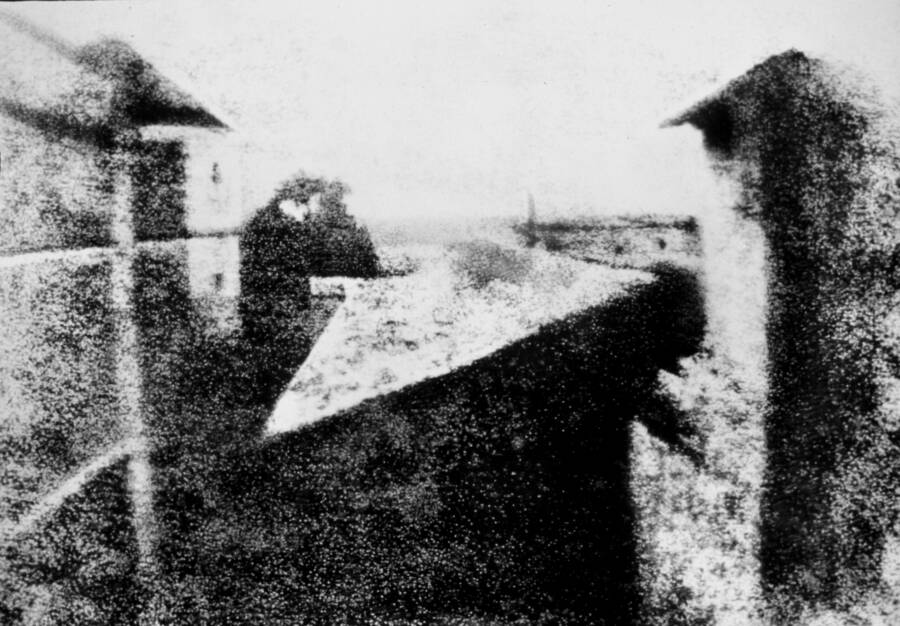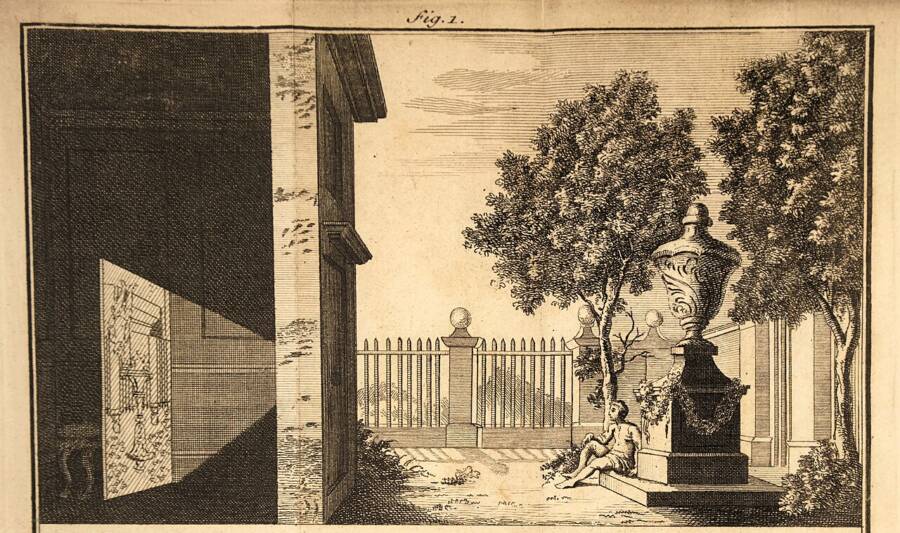Joseph Nicéphore Niépce took the first photo ever, "View from the Window at Le Gras," from his estate in France in 1826 or 1827 using a technique he'd invented called heliography and a camera obscura.
Today, most of us walk around with an incredibly powerful camera in our pockets. We don’t think twice about taking photographs of our world, from our pets to beautiful landscapes to our family and friends. We’ve come a long way from what the first photo ever taken looked like.
Here it is, the first picture in history:

Public DomainThe first photo ever taken may not look like much — but it heralded the beginning of a new technology that changed the world.
This image looks like a charcoal sketch or perhaps some kind of strange Rorschach test. But it’s actually something much more consequential: a first, tentative step forward in the field of photography.
Captured by Frenchman Joseph Nicéphore Niépce in 1826 or 1827, the so-called “View from the Window at Le Gras” marked the beginning of photography as we know it. However, it took Niépce significant experimentation to produce the first photograph ever taken, and the technology would swiftly grow after his death in 1833.
Joseph Nicéphore Niépce, A Photography Pioneer

Public DomainFrench inventor Joseph Nicéphore Niépce.
Born on March 7, 1765, Joseph Nicéphore Niépce spent much of his adult life experimenting with new technology.
His first major invention was an internal-combustion engine, which Niépce built with his brother in 1807 and called a pyréolophore (its name came from the Greek words for “fire,” “wind,” and “I produce”). But as their 10-year patent on the engine began to run out, Niépce shifted his focus.
Starting in 1816, Niépce began to tinker with what he called héliographie or “sun writing.” Through trial and error, Niépce was able to produce images on paper coated with silver chloride, but the images were reversed (negatives), and they darkened completely when exposed to sunlight.
The failure was frustrating, but Niépce pressed on. A decade later, his experimentation with various chemicals, materials, and techniques led him to develop the first photo ever taken.
The First Photo Ever Taken: “View From The Window At Le Gras”
In 1826 or 1827, Niépce succeeded in producing the first photograph ever taken. As the Harry Ransom Center reports, he “dissolved light-sensitive bitumen in oil of lavender” then applied a coating of the mixture over a pewter plate.
Next, Niépce slid the plate into a camera obscura. This technology had existed in one form or another for centuries — it was described as long ago as the 4th century B.C.E. — and is basically a dark space with a small hole. As light pours through the hole, it projects a reverse image of the scene outside on the interior wall.

Public DomainAn 18th-century illustration showing how a camera obscura works.
As early as 1816, Niépce had mused on the potentials of the camera obscura, writing to his brother that it could be used as “a kind of artificial eye, simply a little box, each side six inches square; which will be fitted with a tube that can be lengthened and carrying a lenticular glass.”
A decade later, he harnessed the technology to produce his photograph. With the pewter plate in place, he moved the camera obscura near a second-story window at his home in Saint-Loup-de-Varennes, France. Then, he waited. And waited some more. The first photo in history certainly didn’t reveal itself quickly.
Eight hours later, Niépce found that his experiment had worked. After a long exposure to sunlight, the plate yielded an impression of the courtyard, outbuildings, and trees outside. It didn’t look like much, but “View from the Window at Le Gras” (named for Niépce’s estate) was a remarkable thing. It was the first photo ever taken.

Jonnychiwa/Wikimedia CommonsNiépce’s original plate on the left and a color enhanced version on the right.
As the Harry Ransom Center reports, Niépce knew that his experiment was just the beginning of an exciting new technology. In December 1827, he called it “the first uncertain step in a completely new direction.” Still, many credit Niépce with inventing the camera because of how he utilized a camera obscura to produce his historic image in Saint-Loup-de-Varennes.
And after he took his picture, the field of photography began to grow.
The Growth Of Photography After Niépce’s First Picture
The history of photography, by most accounts, began with Niépce and “View from the Window at Le Gras,” the first photo ever. But the technology would soon expand far beyond Niépce’s blurry pewter plate.
In 1829, Niépce starting working with Louis-Jacques-Mandé Daguerre, a fellow photography pioneer. Though Niépce died just a few years later, in 1833, Daguerre went on to create the daguerreotype. This technique built upon Niépce’s by using highly reflective sheets of silver-plated metal, treating the sheets with fumes, and exposing them to light.
It allowed Daguerre to capture the first photograph with a human subject, and the daguerreotype was used to take pictures until the 1860s. At that point, it was made obsolete by new photography technology.

Public DomainThis photo, taken by Louis Daguerre in 1838, is the first to show a human being (on the left side of the frame).
During the 19th century, the field of photography reached vibrant new heights as color photography was slowly perfected. And by the end of the 19th century, advances had been made in movie-making technology as well.
Before long, technology existed that could capture images unlike anything anyone had ever imagined before. People no longer sat for portraits but for photography sessions. Sights and sounds from around the world were no longer described only in books but also in movies and vivid images.
Today, we take for granted how easy photography is. It takes next to no thought at all to pick up our phones and take a photo — or even a video — which we can instantly share with friends, family, and strangers online.
But in Niépce’s day, when he captured the first photo ever taken, such technology would have seemed impossible. The French inventor had to labor over different chemicals and techniques for close to a decade before he succeeded. Even then, his blurry image took a full day to produce.
His “View from the Window at Le Gras” might not look like much today. But as the first photo ever taken, it represents an exciting step in photography whose effects reverberate to this day.
After seeing the first photograph ever taken, check out our gallery of influential photographs that changed the world. Then, look through these stunning color photographs from around the world at the dawn of the 20th century, financed by French banker Albert Kahn.





